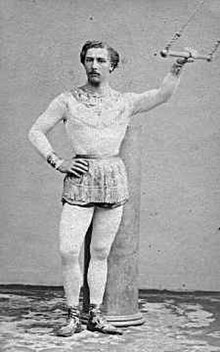Jules Léotard
Jean-Marie Jules Léotard (born August 1, 1838 in Toulouse , † August 16, 1870 there ) was a French artist . He invented and was the first person to perform the rope act “flying trapeze” in the air. The performance was so unusual for the time that in 1867 the song "The Daring Young Man on the Flying Trapeze" , written by George Leybourne , was written. He was also the inventor of a leotard, named after him Leotard .
Life
Léotard was born in Toulouse in the south of France in 1838 as the son of an artist and acrobatics teacher . Young Jules was passing his exams and seemed destined for a legal career. But at the age of 18 he began to experiment with trapezoids , sticks , ropes and rings that were hung over a swimming pool . His father Jean ran this pool commercially and trained Jules.
In 1869, together with Clément Ader, in the early days of cycling , Jules Léotard organized the first cycle race in the Pyrenees and won the ride between Toulouse and Villefranche . In Toulouse, the artist opened a sports hall (14, Rue Rempart Saint-Etienne), which is now a synagogue .
While on tour in Spain, he is said to have contracted smallpox or cholera , which led to his death in 1870.
Career as an artist
He became a member of the "Cirque Napoléon", which - renamed Cirque d'hiver in 1871 - still exists in Paris today. On November 12, 1859, he made his first public appearance as a trapeze artist. As such, he was the first person to do a somersault in midair and the first to jump from one trapeze to another.
The circus act lasted 12 minutes, in which Léotard gymnastics with and between three trapezoids and finally ended with a somersault on the carpeted safety mat. This presentation was so revolutionary that his colleagues donated a banquet in his honor and a commemorative medal was minted.
Jules Léotard developed into a heartthrob . The newspaper Le Figaro published a report on 21 June 1860 at a vaudeville - comedy under the title "Les Amoureuses de Léotard" ( "Lovers of Léotard"). There are said to have been women pushing themselves to get into the first row of seats to watch Léotard fly through the air.
In May 1861 he made his debut at the Alhambra Theater in Leicester Square , London with his aerial rope act. The trapeze act was performed over the heads of the audience and was immensely popular. He was paid £ 180 a week for this, the equivalent of almost £ 5,000 by today's standards. At Ashburnham Hall in Cremorne Gardens he made an appearance on five trapezoids with a somersault between each.
After several seasons at the “Cirque Napoléon”, he toured Europe and the United States of America.
In 1866 the star appeared again in London and in 1868 mainly in variety theaters and " Pleasure Gardens ", where he was extremely well received.
clothing
Jules Léotard invented a skin-tight one-piece garment with long sleeves, which he called maillot and wore it when he was introduced. It was designed to allow unrestricted movement and to show off your muscles . It was relatively aerodynamic and had no flapping parts to tangle with the ropes. Léotard's clothing quickly became the outfit for tightrope walkers and aerial acrobats . The garment made its way from the circus to the ballet studios of Paris. It is known today as leotard : the first reported use of this term in English dates back to 1886. (The French word maillot now means bathing suit .)
Others
A variety of mattresses were often used at Jules Léotard's appearances in the event of an accident. The first safety net was set up in 1871 by a Spanish troop, the "Rizarellis", in the "Holborn Empire".
Jules Verne mentioned Léotard's name (and that of the tightrope walker Charles Blondin ) in the first chapter of his novel Journey around the Earth in 80 Days in the scene when the servant Jean Passepartout was hired by Phileas Fogg.
literature
- Susanne Schüssler, Maren doctor (editor): Salto! 99 jumps in the air, somersaults and other tricks. Berlin 2001, ISBN 3-8031-1199-4
- Jules Léotard: Memoires de Léotard. Chez Tous les Libraires, Paris 1860.
- Novellas by William Saroyan (1908–1981): L'audacieux jeune homme au trapèze volant ; Translated from English into French by Jacques Havet.
- Gisela and Dietmar Winkler (editors): "Allez hopp durch die Welt. From the life of famous acrobats", 2nd edition 1987, ISBN 3-362-00127-0
Web links
Individual evidence
- ↑ http://www.cs.utep.edu/novick/dispatchToulouse/dispatch980120.html
- ↑ http://www.chez.com/toulousegardedenfants/leotard.htm
- ↑ Jules Leotard, at peopleplayUK ( Memento of the original from November 19, 2007 in the Internet Archive ) Info: The archive link was inserted automatically and has not yet been checked. Please check the original and archive link according to the instructions and then remove this notice.
- ↑ Archive link ( Memento of the original dated November 13, 2007 in the Internet Archive ) Info: The archive link was inserted automatically and has not yet been checked. Please check the original and archive link according to the instructions and then remove this notice.
| personal data | |
|---|---|
| SURNAME | Léotard, Jules |
| ALTERNATIVE NAMES | Léotard, Jean-Marie Jules (full name) |
| BRIEF DESCRIPTION | French artist and inventor of a garment |
| DATE OF BIRTH | August 1, 1838 |
| PLACE OF BIRTH | Toulouse |
| DATE OF DEATH | August 16, 1870 |
| Place of death | Toulouse |

